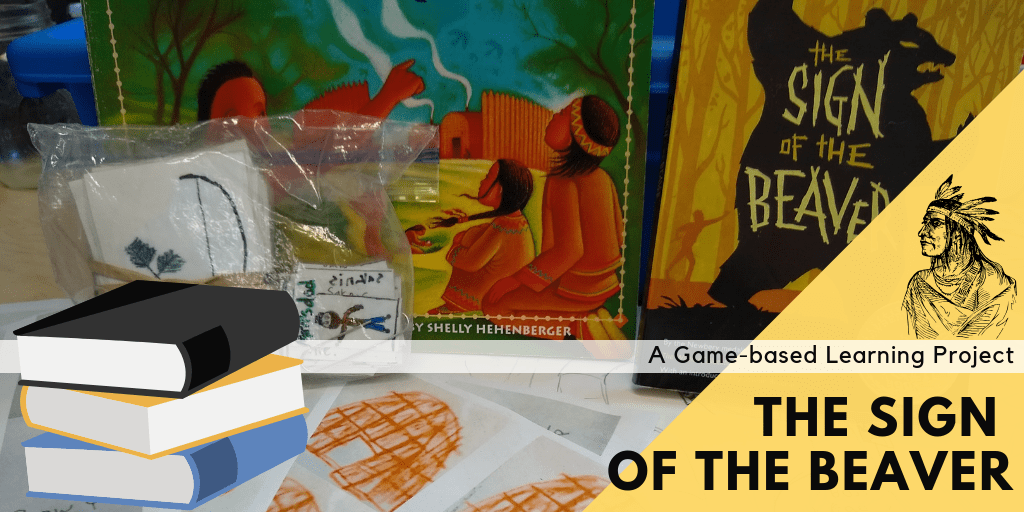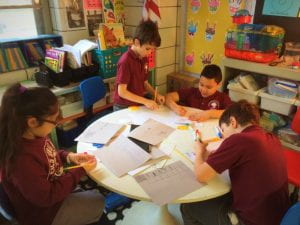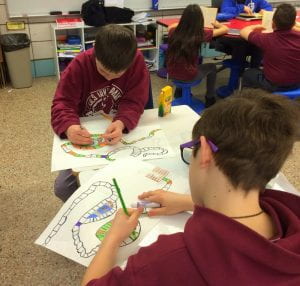
The Sign of the Beaver: A Game-based Learning Project
After leading a small Lit Circle with some 3rd & 4th graders we took our text, The Sign of the Beaver, and turned it into a board game. A fun and effective activity that utilized both project-based and game-based learning. Literacy instruction isn’t typically within my wheelhouse but I was really proud of the work my students accomplished and wanted to share the lesson and materials.
https://www.teacherspayteachers.com/Product/The-Sign-of-the-Beaver-A-Game-based-Learning-Project-4673374
Being an enrichment teacher is a tough job. You sort of exist at the school on an island, which has it’s perks and drawbacks. A perk is that I have a high level of autonomy and trust from my administration, but a drawback is that no one is quite sure what I do on a day-to-day basis. I have my suspicions that it was for this reason that enrichment teachers were pulled into classrooms this past year to help lead small group lit circles with 3rd and 4th graders. Its frustrating to be pulled away from your subject material in order to support a classroom teacher, and it reinforces the unspoken hierarchy of subjects in schools (which I’ve talked about before). Unfortunately, it’s honestly very common for teachers, especially enrichment teachers, to be pulled in multiple directions, so I tried to take it as an opportunity rather than a slight against my profession.
We read Elizabeth George Speare’s Newbery Award-winning “The Sign of the Beaver” and over the course of the text, my reading instruction improved a lot! Because I had no guidelines or support with the new role, I started with “round-robin” reading, but a reading specialist at school kindly provided me some alternatives. It was fine because the students loved the book, especially big fat Civil War Ben who eats all the main character’s food and robs him early in the book (they were a weird group). They loved it so much that when we were done they didn’t want to give it up, so I talked to the classroom teacher and asked what are the important elements that she wanted her students to learn and they were typical things like theme, characterization, setting, supporting evidence, etc. I’ve long been a fan of game-based learning, particularly inspired by NY’s Quest School, and wanted to try my hand at it.
The Project
 The project was to take the text and transform it into a playable board game. We would use the different elements of the actual game to review the aspects of the book. The game pieces would be characters from the text, with short descriptions on the back, the board itself would be a visual representation of the settings, and there were game cards that covered plot points as well as conflict that took place. The players would go through the same events that the main characters of the story did as they played through the game. It’s sounds simple enough but in order to do this students really needed to know the text. All throughout the project they were flipping through the book going back, re-reading old passages (and not just skimming, but actual close reading) in order to get the details rights. I really let them have a lot of freedom in terms of the rules, I just set out of a few basic jobs. (click the links for visuals)
The project was to take the text and transform it into a playable board game. We would use the different elements of the actual game to review the aspects of the book. The game pieces would be characters from the text, with short descriptions on the back, the board itself would be a visual representation of the settings, and there were game cards that covered plot points as well as conflict that took place. The players would go through the same events that the main characters of the story did as they played through the game. It’s sounds simple enough but in order to do this students really needed to know the text. All throughout the project they were flipping through the book going back, re-reading old passages (and not just skimming, but actual close reading) in order to get the details rights. I really let them have a lot of freedom in terms of the rules, I just set out of a few basic jobs. (click the links for visuals)
Characters – Game Pieces
*If you are on this team you have to create game piece for the players to use; each piece should be a character from the story. The front should have a drawing of the character and on the back should be a description of who they are and what they did in the story.
Setting – Board Maker
*This team creates the actual board, the board should have the different places that the characters in the book went, the game path should follow them so the players can visit them too. If there’s a major plot point make a split in the path so the players have to make a choice! (all paths must end at the same spot)
Plot – Game Cards
*What happened that was good? What happened that bad? Create cards for the players to draw so they can experience the same things our characters in the story did. Good cards should help the players and bad cards should harm them.
Theme – Rules & Cover Art
*What do you think the whole book was about? What was the main ideas or theme? Can you have our players feel the same way that Matt and Attean felt? Rules should be easy to understand and fair to all players (remember you have to play too!)
 The game was really simple, basically like Candyland or Chutes (Snakes) and Ladders. Roll a dice, move your piece, if you land on a space draw a card, and the first to the end wins. However I really beyond impressed with the effort and thought my students put into the game. They came up with challenges and choices, things like a split in the board where one side was safer and longer and the other shorter and riskier, they create a “boss battle” which you’d have a bonus at if you saved your supplies, and a bunch of other mechanics that promoted planning and foresight (which is a central theme of the text!). Of course they also put in typical kid stuff (Matt’s late baby sister was a playable character – or – if you draw this card you die and have to go back to the beginning of the game) but all those elements made it more fun and engaging for them. In the end it was a huge success and exceeded my expectations. Above all else, my students learned a lot. The didn’t just learn about the text, or the literary elements, but they also collaborated together on a project. Everyone participated in different ways, contributing what they were good at, and it was a really positive environment. I know that project-based learning, and game-based in particular, can be tough. However, I saw first hand if you do these projects the right way, with planning and guidelines, just how effective they can be!
The game was really simple, basically like Candyland or Chutes (Snakes) and Ladders. Roll a dice, move your piece, if you land on a space draw a card, and the first to the end wins. However I really beyond impressed with the effort and thought my students put into the game. They came up with challenges and choices, things like a split in the board where one side was safer and longer and the other shorter and riskier, they create a “boss battle” which you’d have a bonus at if you saved your supplies, and a bunch of other mechanics that promoted planning and foresight (which is a central theme of the text!). Of course they also put in typical kid stuff (Matt’s late baby sister was a playable character – or – if you draw this card you die and have to go back to the beginning of the game) but all those elements made it more fun and engaging for them. In the end it was a huge success and exceeded my expectations. Above all else, my students learned a lot. The didn’t just learn about the text, or the literary elements, but they also collaborated together on a project. Everyone participated in different ways, contributing what they were good at, and it was a really positive environment. I know that project-based learning, and game-based in particular, can be tough. However, I saw first hand if you do these projects the right way, with planning and guidelines, just how effective they can be!
Make sure you watch the video to see the project in action! If you have questions please leave them in the comments below, and here are some of my resources:
Books:
If you Lived with the Iroquois
Worksheets:
Guides:
Dorothy July 9, 2019 - 5:07 pm
Amazing Frank! Many times when a person finishes reading a book that they enjoyed, it’s a disappointment that the story is over. Being able to incorporate characters, locations etc of that book into a game lets you keep enjoying the story! What a fantastic idea and teacher you are!
Kelly October 9, 2021 - 9:52 pm
I like this idea… I have a few questions. Was this a group assignment? How did you divide the jobs? Did the team have to work together to design the game? Did you have a rubric?